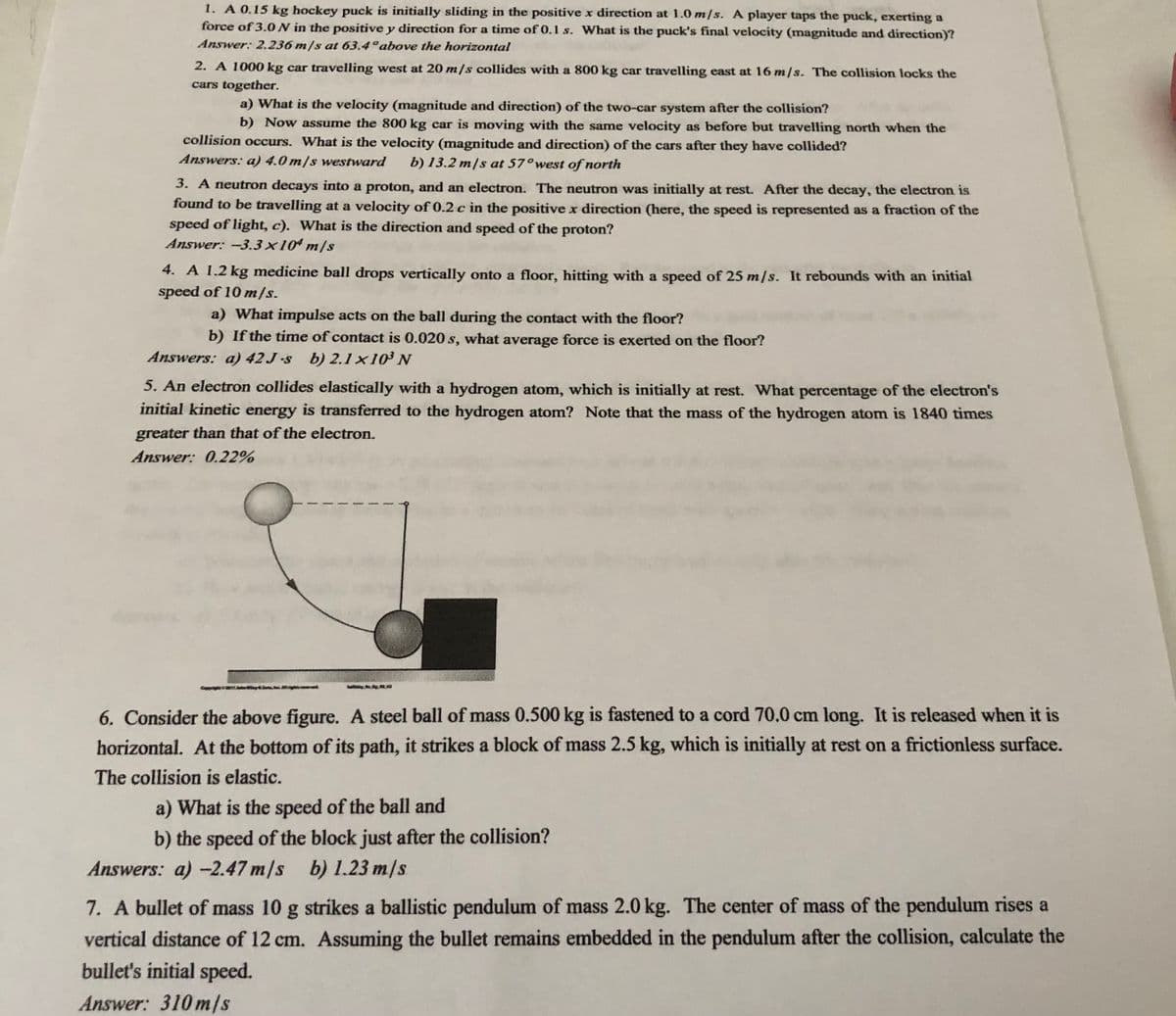west of north 3. A neutron decays into a proton, and an electron. The neutron was initially at rest. After the decay, the electron is found to be travelling at a velocity of 0.2 c in the positive x direction (here, the speed is represented as a fraction of the speed of light, c). What is the direction and speed of the proton? Answer: -3.3 x10 m/s
west of north 3. A neutron decays into a proton, and an electron. The neutron was initially at rest. After the decay, the electron is found to be travelling at a velocity of 0.2 c in the positive x direction (here, the speed is represented as a fraction of the speed of light, c). What is the direction and speed of the proton? Answer: -3.3 x10 m/s
Physics for Scientists and Engineers: Foundations and Connections
1st Edition
ISBN:9781133939146
Author:Katz, Debora M.
Publisher:Katz, Debora M.
Chapter6: Applications Of Newton’s Laws Of Motion
Section: Chapter Questions
Problem 77PQ
Related questions
Question
Please solve question 3

Transcribed Image Text:1. A 0.15 kg hockey puck is initially sliding in the positive x direction at 1.0 m/s. A player taps the puck, exerting a
force of 3.0 in the positive y direction for a time of 0.1 s. What is the puck's final velocity (magnitude and direction)?
Answer: 2.236 m/s at 63.4°above the horizontal
2. A 1000 kg car travelling west at 20 m/s collides with a 800 kg car travelling east at 16 m/s. The collision locks the
cars together.
a) What is the velocity (magnitude and direction) of the two-car system after the collision?
b) Now assume the 800 kg car is moving with the same velocity as before but travelling north when the
collision occurs. What is the velocity (magnitude and direction) of the cars after they have collided?
Answers: a) 4.0 m/s westward
b) 13.2 m/s at 57°west of north
3. A neutron decays into a proton, and an electron. The neutron was initially at rest. After the decay, the electron is
found to be travelling at a velocity of 0.2 c in the positive x direction (here, the speed is represented as a fraction of the
speed of light, c). What is the direction and speed of the proton?
Answer: -3.3×10 m/s
4. A 1.2 kg medicine ball drops vertically onto a floor, hitting with a speed of 25 m/s. It rebounds with an initial
speed of 10 m/s.
a) What impulse acts on the ball during the contact with the floor?
b) If the time of contact is 0.020 s, what average force is exerted on the floo
Answers: a) 42 J.s b) 2.1 x10³ N
5. An electron collides elastically with a hydrogen atom, which is initially at rest. What percentage of the electron's
initial kinetic energy is transferred to the hydrogen atom? Note that the mass of the hydrogen atom is 1840 times
greater than that of the electron.
Answer: 0.22%
6. Consider the above figure. A steel ball of mass 0.500 kg is fastened to a cord 70.0 cm long. It is released when it is
horizontal. At the bottom of its path, it strikes a block of mass 2.5 kg, which is initially at rest on a frictionless surface.
The collision is elastic.
a) What is the speed of the ball and
b) the speed of the block just after the collision?
Answers: a) -2.47 m/s b) 1.23 m/s
7. A bullet of mass 10 g strikes a ballistic pendulum of mass 2.0 kg. The center of mass of the pendulum rises a
vertical distance of 12 cm. Assuming the bullet remains embedded in the pendulum after the collision, calculate the
bullet's initial speed.
Answer: 310 m/s
Expert Solution
This question has been solved!
Explore an expertly crafted, step-by-step solution for a thorough understanding of key concepts.
Step by step
Solved in 2 steps with 2 images

Knowledge Booster
Learn more about
Need a deep-dive on the concept behind this application? Look no further. Learn more about this topic, physics and related others by exploring similar questions and additional content below.Recommended textbooks for you

Physics for Scientists and Engineers: Foundations…
Physics
ISBN:
9781133939146
Author:
Katz, Debora M.
Publisher:
Cengage Learning

Classical Dynamics of Particles and Systems
Physics
ISBN:
9780534408961
Author:
Stephen T. Thornton, Jerry B. Marion
Publisher:
Cengage Learning

Physics for Scientists and Engineers, Technology …
Physics
ISBN:
9781305116399
Author:
Raymond A. Serway, John W. Jewett
Publisher:
Cengage Learning

Physics for Scientists and Engineers: Foundations…
Physics
ISBN:
9781133939146
Author:
Katz, Debora M.
Publisher:
Cengage Learning

Classical Dynamics of Particles and Systems
Physics
ISBN:
9780534408961
Author:
Stephen T. Thornton, Jerry B. Marion
Publisher:
Cengage Learning

Physics for Scientists and Engineers, Technology …
Physics
ISBN:
9781305116399
Author:
Raymond A. Serway, John W. Jewett
Publisher:
Cengage Learning